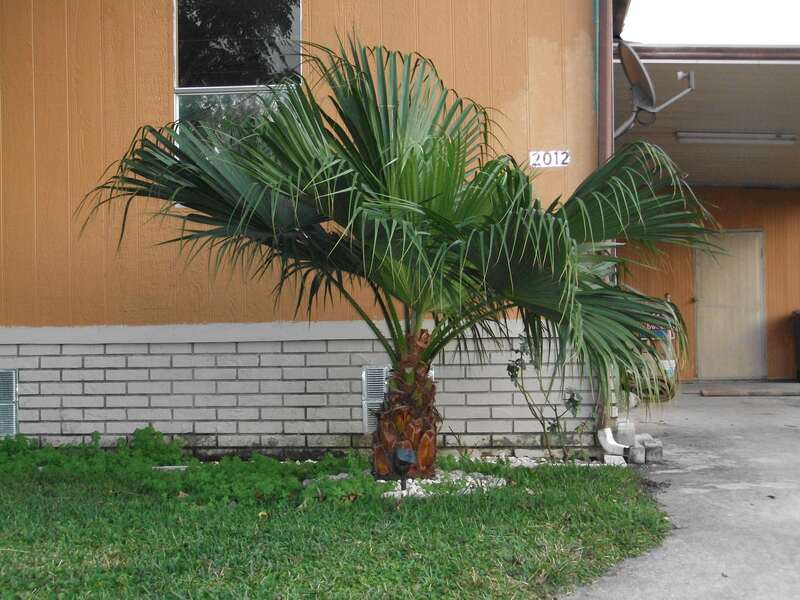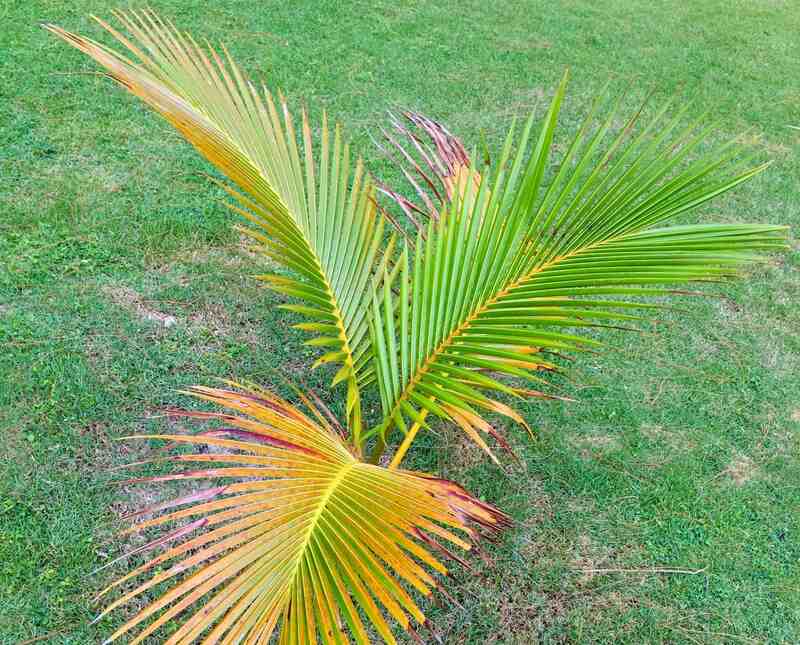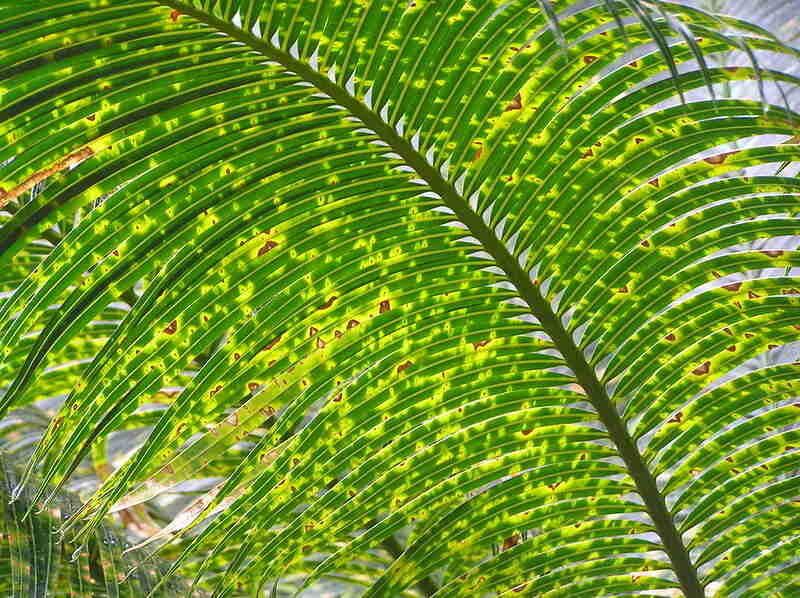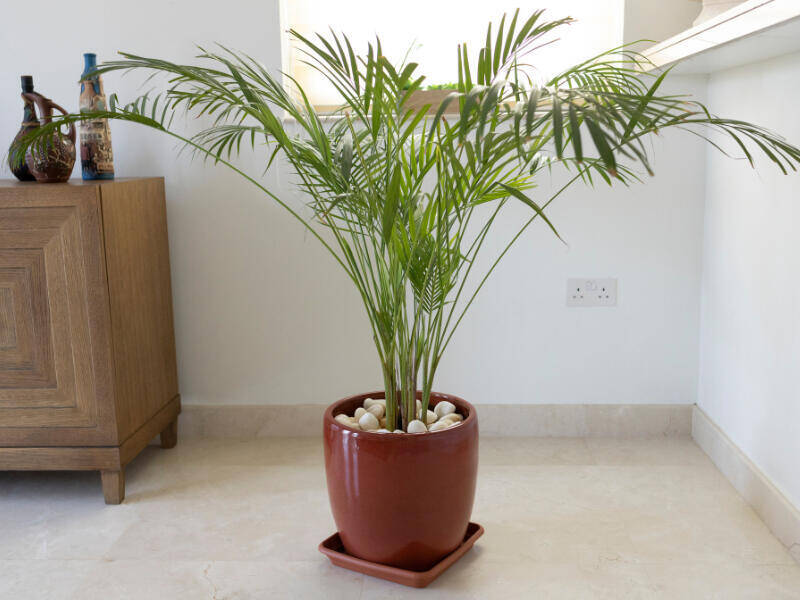
Nothing gives the same lush, tropical vibe as a landscape full of majestic palm trees. We’ve debunked some common myths and will cover essential tips on how to care for your palm trees like a pro.
Why Care For Palm Trees
Healthy palms produce lush, robust growth, and their addition can almost instantly change a bland yard into a tropical paradise. With so many different choices in palms, your biggest problem will be choosing which one to bring home.
Palm trees need little to no upkeep once established, but there are a few things to keep in mind, especially for freshly planted palms.
How To Water Palm Trees

Whether you have a newly planted, outdoor, or potted palm, here’s how to water your palm tree.
For newly planted palms: Most palm tree species are relatively drought tolerant once established, but you’ll need to water consistently to get it to that point. According to the University of Florida, establishing a new palm root system might take anywhere from 6 months to a year. The transplanted palm must receive sufficient water during this phase.
You may need to water your new palm daily, depending on the soil type, moisture-holding ability, and local climate. This is especially true if your soil is sandy and outside conditions are hot and dry.
For the first 10 to 14 days, water your freshly planted palm tree every day. After that, you can go every other day, three to four times weekly.
Most palm species cannot thrive in soils constantly saturated with water. It is vital to transplant your palm into well-draining soil.
For outdoor palms: Depending on the species of the palm tree, its drought tolerance, and your local weather conditions, the watering needs of your palm can vary. According to the University of Florida, the average watering recommendations are as follows:
- Trees 1-2 years old: Typically require three to four weekly waterings.
- Trees 3-4 years old: Require two to three water applications weekly.
Water deeply (between 1.5 and 2.5 gallons) when watering, so it reaches the root ball. Doing this promotes a more robust, healthier root system. Break each watering into multiple shorter sessions to reduce runoff and avoid trunk rot.
Palm trees grown in containers might require water daily through the active growing season of spring and summer. In addition, potting soil dries out quicker than soil in the landscape, primarily if contained in a porous container such as terra cotta. During winter, the palm tree goes dormant. Its growth slows, so its water requirements drop.
For potted palms: It’s easy to check if your potted palm requires water.
- Finger test: Stick your finger into the potting mix. If the top 3-4 inches of soil feels dry to the touch, water the palm tree until it runs out of the pot’s bottom drain holes.
- Let it dry: As with overwatering palms in the landscape, it’s best to allow the potting mix to dry slightly before watering. If you don’t, your palm tree can develop root rot and die due to constantly soggy conditions.
How To Fertilize Palm Trees

Fertilizing at the right time and with a suitable palm fertilizer containing all the macronutrients needed for healthy growth is an essential aspect of palm tree care.
Proper fertilization:
- Keeps the palm looking good and growing healthy
- Increases the palm’s hardiness
- Eliminates health problems associated with nutritional deficiencies
Remember, it’s easier to prevent problems associated with deficiencies than correct them after they’ve reared their ugly head.
But First, Test the Soil
The biggest mistake people make? According to Sally Scalera, Urban Horticulture Agent & Master Gardener, UF/IFAS Extension Brevard County, “Not testing the soil first before fertilizing. Excess levels of nutrients will tie up other nutrients, so it is just as important to know what nutrients are in excess levels as it is for those that are present in low levels.”
Before spreading palm fertilizer around, it’s vital to get a soil test to know if your soil lacks any nutrients. This lets you know precisely what your palm needs to keep it healthy and looking its best.
When to Fertilize Palm Trees
The University of Florida suggests fertilizing four times yearly, but you should wait until you see your palm producing new growth before its first feeding. After a month or so, you’ll see new palm fronds developing, and now it’s time to fertilize.
Palm Tree Fertilizer Selection and Use
When it comes to selecting and using a standard palm fertilizer that works best, the University of Florida recommends:
- Use a palm fertilizer labeled “8-2-12-4 Mg” that includes all micronutrients.
These nutrients are indicated like this on a fertilizer package: 8-2-12-4. Each number indicates the amount of each nutrient, always in the same order (nitrogen-phosphorus-potassium plus magnesium). So, this fertilizer contains 8% nitrogen, 2% phosphorus, and 12% potassium plus 4% magnesium. - One hundred percent of Nitrogen (N), Potassium (K), and Magnesium (Mg) should be in a controlled release form.
- Use at a rate of 1.5 pounds per 100 square feet of the palm’s canopy.
- Spread evenly under the canopy, being sure to keep the fertilizer about 4 inches from the trunk to prevent burns and damage.
Your soil test will let you know if you need additional nutrients and in what amounts. Always water any fertilizer products into the soil after applying.
How To Prune Palm Trees

Pruning the palm tree is an essential element of its care. Failure to do so can weaken the tree’s health and even cause it to die. This is one reason to choose a suitable area before planting. For palm trees to reach their full potential, grow them away from structures, electrical lines, or sidewalks.
There’s one crucial rule of pruning palm fronds – don’t trim anything but completely brown and dead fronds. Trimming off green fronds is an excellent way to weaken any palm species. Even palm fronds with the slightest bit of color are still nourishing the entire tree.
Palm fronds go through a natural lifecycle of slowly browning, eventually leading to completely dead fronds. Depending on the palm species, this process can take several months. Only then should you prune off the frond. Additionally, some palm species are self-cleaning and drop their dead fronds.
Expert Tip: If you live in a hurricane-prone area, you’ve undoubtedly heard lawn services advertise palm tree “hurricane cuts.” Don’t fall for it since it’s a money-grabbing scam with little regard for the health of your palm trees.
This trimming method scalps the tree, leaving only a few fronds extending from the top. The University of Florida recommends avoiding this since it weakens the tree, can result in health problems, and ultimately kill your palm.
Winterizing Palm Trees

Most palm species won’t tolerate a cold snap that brings along frosts and a hard freeze. If you live in an area with year-round frost-free weather, you probably won’t have to worry about winter protection. Those who endure rare freezing snaps need to prepare.
Additionally, this is another reason why it’s good to know the hardiness requirements of your palm. Check your USDA growing zone to select palms that will tolerate your area’s lowest winter temps.
The steps to protecting your outdoor and potted palms before a cold snap are relatively basic.
Palms in the Landscape
- Water the planting site, saturating the root ball the day before the predicted cold weather. It helps insulate it from the cold.
- Apply a 3- to 4-inch layer of mulch over the planting site to help insulate the palm’s root system.
- Wrap the trunk in burlap.
- If the palm isn’t too tall, string holiday lights through the fronds and canopy, or wrap them in a cotton sheet or landscape fabric. Using a string of lights can add 2-3 degrees Fahrenheit to the temperature.
Potted Palms
- Water the potted palm tree.
- Move the potted palm tree to an indoor location with natural light close to what it was receiving outdoors.
- If the potted palm is too large to move, place it close together with a grouping of other potted plants to help with insulation.
- If left outdoors, you can string holiday lights through the canopy or cover them with a sheet.
Expert Tip: If you think your palm suffered damage from the cold, wait until the palm fronds are completely dead and brown before trimming them off.
Palm Tree Problems

Despite their carefree appearance, palm trees in the landscape are susceptible to various diseases, pests, and nutritional problems. These concerns are prevented by following the recommended care practices that keep plants strong and healthy.
Palm Tree Diseases
- Ganoderma Butt Rot: This disease is caused by the fungus Ganoderma zonatum, which can infect any palm tree.
The first sign of infection is withering and drooping of old leaves. The most easily recognizable symptom of this fungus is the basidiocarp, also known as a conk. After the conks appear on the trunk, remove the palm as soon as possible. While you wait, remove conks as they pop up to prevent the spores from spreading.
Treatment and prevention: This disease has no chemical treatment. If you find a conk, it’s best to remove the tree. Because this fungus feeds on plant tissue; remove and destroy any palm roots, stumps, and trunks in the landscape.
Ganoderma zonatum lives in the soil; thus, planting another palm in the same spot is not advised.
- Leaf Spots: Many leaf-spotting fungi regularly afflict palms. Leaf spots can vary from round to elongated, brown, and even greasy looking. Visual symptoms alone are unreliable for identifying the leaf-spotting fungus.
Treatment and prevention: Do not water the palm fronds. In most circumstances, leaf spots do not destroy the tree, and fungicides are rarely required. Use fungicidal sprays containing copper if the damage becomes severe.
- Bud Rot: A variety of fungal infections, as well as bacterial pathogens, can cause this disease. Bud rot often arises after freezing temperatures, hurricanes, or a period of heavy rain.
Treatment and prevention: Avoid using overhead watering whenever possible. Once infected, plant recovery is unlikely. Remove diseased palms and destroy them as soon as possible to limit disease transmission. On sick plants, copper-containing preventative fungicides can help.
- False Smut: The fungal Graphiola species causes false smut or Graphiola leaf spot. This disease is extremely prevalent in humid climates. Small, black wart-like forms sprout through both leaf surfaces of infected, older fronds. From the black patches, tiny threads may emerge.
Treatment and prevention: Carefully space palms to allow for sufficient airflow and humidity reduction. When watering, avoid wetting the fronds. Remove and destroy badly infected fronds to avoid spreading the disease. However, removing too many fronds may be worse for the palm than the disease itself.
Fungicides are usually unnecessary; however, they aid as a protective measure in the spring.
Only palms from the Arecaceae family are vulnerable. This includes: sabal palmetto (Sabal palmetto), jelly or pindo palm (Butia capitata), Chinese fan palm (Chamaerops humilis), and Washington palm (Washingtonia robusta).
Common Nutritional Deficiencies in Palms
Palm trees can suffer from nutritional deficiencies of important elements like potassium (K), nitrogen (N), manganese (Mn), and magnesium (Mg).
When they lack particular nutrients, palm trees will let you know by exhibiting certain symptoms. You can always take a sample of your palm to your local county Extension service office to get a diagnosis and find out what you can do to correct the problem.
Common signs of nutritional deficiencies and their causes include:
- Nitrogen: The palm’s growth rate is greatly reduced, plus older or even all the palm leaves show uniformed chlorosis (yellowing).
- Potassium: Fronds have a necrotic (dead tissue) or translucent orange-yellow spotting. Older fronds have a frizzled appearance that is most severe on the tips, and the deficiency can be fatal to the palm. Treatable with sulfur-coated potassium sulfate.
- Magnesium: The oldest fronds show marginal chlorosis. Treatable with magnesium sulfate.
- Iron: The newest fronds show generalized chlorosis, and the leaf veins are green and sharply defined. In soils that are too alkaline, treat with chelated iron.
- Manganese: Newest fronds are smaller than normal, frizzling at the leaf base and with interveinal chlorosis and necrotic streaking. It can be fatal to the palm. Treatable with manganese sulfate or by altering soil pH (if soil test determines this is necessary).
- Boron: Newest fronds become crumpled, smaller than normal, and sometimes there’s a horizontal sharp bend in the trunk. It can kill the center bud of the palm tree.
Palm Tree Pests
Healthy palm trees are naturally resistant to most insect-borne illnesses, but damage brought on by transplanting, the cold, or other factors leaves the plants more prone to infection.
The following is a list of palm tree pests that can transmit disease:
- Spider mites: White spider (Polyphagotarsonemus latus) or red spider (Tetranychus urticae) mites attack the tender leaves harming their development. During spring and summer, they multiply mainly due to the dry air.
According to the University of Minnesota Extension, to check for spider mites, slide a paper plate or a piece of white paper underneath the leaves. Tap the fronds, and if small specks fall or move around, then you have spider mites.
- Palm aphids, or Cerataphis brasiliensis and Cerataphis lataniae, look like a whitefly or a scale insect instead of an aphid. The body is oval, slightly concave to flat with a white wax edge. Palm aphids suck out the fluids, weakening the plant, and severely damage the palm. The aphids’ excretions cause sooty mold.
The first line of defense for aphids: Carefully check recently bought palm trees for their presence. Keeping these pests out of your landscape will help stop destructive infestations.
- Mealybugs: The palm mealybug (Palmicultor palmarum) are found In between the leaves and the fruit, colonies appear as white, sticky patches. Mealybugs damage plants by sucking plant liquids and excreting honeydew, which encourages the development of sooty mold and attracts ants.
Neem oil has been recommended for natural pest control of thrips, mealybugs, and even some fungi that cause diseases.
- Red palm weevils: Rhynchophorus ferrugineus or red palm weevil are the most destructive insects for palm trees in the world. Adult beetles are 1 to 1.5 inches long and rusty red, but several color variations exist.
The life cycle lasts three to four months. In pursuit of nourishment, the larvae use their powerful teeth to bore big holes into the trunk, killing it. When the weevil runs out of food or grows, it looks for new palm trees to attack.
Various weevil species of Asian or South American origin are wreaking havoc due to the illegal importation of non-native species. Preventive fumigation treatment, repeated throughout the year, and parasitic nematodes are two effective strategies for the control of red palm weevils.
Why are my Palm Fronds Turning Brown?
Whether an indoor palm tree or grown outdoors, if your potted palm’s frond tips are turning brown, it signals a problem: It’s not getting enough water, there’s not enough humidity, or the fertilizer salts are producing burns. A process of elimination should solve the problem, and prevention is basic:
- Increase humidity by misting the palm tree with room temperature water several times weekly or placing the container on a tray of pebbles. Humidity is created as the water evaporates from the pebble-lined tray.
- Don’t over-fertilize and use slow-release palm fertilizer granules that gradually release into the soil when watered. Most slow-release granules don’t require reapplying for up to three months.
- Flush the pot every three to four months to wash away any salt buildup from the fertilizer. Allow water to run slowly through the potting soil for about five minutes.
Follow these steps to reduce browning frond tips even if you’re growing the palm tree as a house plant.
Indoor Palm Tree Care Tips

If you take good care of your palm, the fronds may eventually graze against your rafters.
- Light: Palms are happiest when they are growing in bright, indirect light. They will survive the winter, even when there is much less sunlight available, as many palms are shade tolerant.
If there isn’t any natural light in the room, invest in a grow light for your plant. Don’t take it to the other extreme either; if you want to give your palm tree some fresh air in the summer, put it in a shady spot away from direct sunshine.
- Water: Keep the soil consistently moist — adequate drainage in your planter is vital. Water your plant whenever you see the top inch of soil is dry.
Expert Tip: Spreading a 3 to 4-inch layer of organic mulch over the planting site helps the soil keep moisture and cuts down on unwanted vegetative growth. Keep mulch pulled about 4 inches back from the palm’s trunk to discourage pest and disease problems.
One sign your palm tree isn’t getting enough water is the tips of the fronds turn brown. Plus, this can also be a sign of too much salt buildup in the soil due to excessive fertilizer use. Although the browning tips won’t change back to a normal color, you can correct the problem.
- Soil mix: A porous, loose soil mix will give the best results since it allows water to drain and air to move through your plant’s container. Potting mixes made of lightweight elements like peat moss, vermiculite, and perlite increase the porosity of the soil.
If you want to take things a step further, there are specialty potting mixes on the market designed for growing palms, or you can make your own.
- Fertilizer: When it comes to basic fertilization practices, the University of Florida suggests fertilizing four times yearly, but you should wait until you see your new palm producing new growth before its first feeding.
- Pruning: Palm leaves naturally turn yellow or brown as they age. It may not be pretty, but aging, discolored fronds are still a vital source of nutrients for your palm tree. Never prune your palm tree for size, and never cut the entire frond back to the palm’s stem if only the tips are brown.
Remember that when grown indoors, your palm is unlikely to flower. Many varieties of palm trees will not live long enough to bloom or develop as houseplants, as many of these are gigantic trees in the wild. The beautiful display of the leaves makes up for the lack of flowers.
FAQ: How to Care For Palm Trees
No. The idea that Epsom salts are a cure-all for whatever ails your palm is just an old wive’s tale.
Sally Scalera, UF/IFAS Extension agent in Brevard County, explains, “Epsom salts supply magnesium, and high levels of magnesium will raise the pH, tighten the soil, and tie up calcium and potassium. It is very common for non-native palms to suffer from potassium and magnesium deficiencies, often at the same time.”
You can put your potted palm trees outside starting in the spring. Before taking palm trees outside, be sure there is no risk of freezing. In the fall, bring them inside whenever the temperature drops to 50 to 55 degrees Fahrenheit overnight.
Take these steps to revive a sickly palm:
• Increase the humidity: Keep the temperature between 65 and 75 degrees Fahrenheit and regularly mist your tree.
• Cut back brown leaves to stimulate growth.
• Water thoroughly, and make sure it’s draining well. Let the soil dry slightly between waterings.
When to Call a Pro
Proper palm tree care is important in keeping your palms hardy, problem-free, and year-round eye-catching specimens. If you’d rather lie by the pool with an umbrella drink than plant and maintain your tropical oasis, reach out to one of our landscaping pros today and break out the sunscreen.
Main Image Credit: Pxhere / CC0 1.0